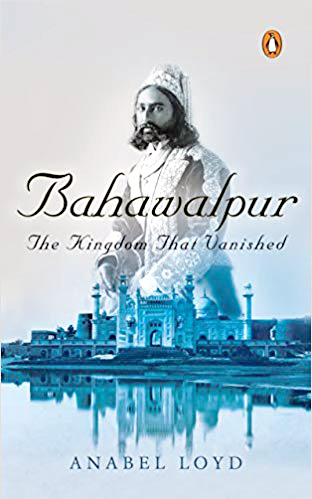It all began with a description of the Coronation Durbar of the King Emperor, George V, and Queen Mary at Delhi in December 1911. At the military review on 14 December, the Indian chiefs led their state troops in person, and it was the youngest of those princes who held all eyes. He was the nawab of Bahawalpur, aged seven, who:
led his camel-corps past, himself riding a camel in front of a grave and trusty trooper. Dressed in full uniform of khaki with gold-embroidered skirts, the little fellow boldly faced the King-Emperor at the saluting point, threw out a baby’s right arm to its full length, and with perfect correctness and time in every motion brought down his tiny sword to the salute. Seventy or eighty years hence, it may be, he will be conspicuous as the only survivor of the many gallant gentlemen who rode past King George on that day.
Seventy years later, that shining child, General Jalalat ul-Mulk, Rukn ud-Daula, Saif ud-Daula, Hafiz ul-Mulk, Mukhlis ud-Daula wa Muin ud-Daula, Al-Haji Nawab Sir Sadiq Muhammad Khan Bahadur Abbasi V, Nusrat-i-Jung, Amir of the God-gifted Kingdom Bahawalpur, GCSI, GCIE, KCVO, ruler of a state the size of Denmark, where the five life-giving rivers of the Punjab combine as the Panjnad, had died five years earlier at his English home. By then, he was no longer a ruling prince; his country had divided and his state had disappeared into the united entity of West Pakistan. His body had been carried back to Bahawalpur, to the palace of Sadiqgarh and thence by gun carriage into the desert to his final resting place in the family mausoleum.
I had never heard of Bahawalpur. John Fortescue, eyewitness chronicler of the 1911 Durbar, wrote truthfully of the Indian people: ‘No one man has ever seen, nor will ever see, in spite of motor cars, and aeroplanes and railways, one hundredth of the eighteen hundred thousand square miles over which they are spread. No one man has ever visited, nor will ever visit all the cities, living and dead, which they have builded.’ Nevertheless, like all visitors to India who have read their South Asian histories and their travellers’ tales, I had some idea that I had at least heard the names at one time or another of most of the former princely states.
Quite wrong, as I discovered when I tackled the list of all 565 states in existence at Independence. They ranged from the twenty-one-gun-salute states, remembered by one British viceroy with the mnemonic ‘hot kippers make a good breakfast’, of Hyderabad, Kashmir, Mysore, Gwalior and Baroda, to the tiny non-salute slip of a village in Gujarat called Vejanoness, with an area of 0.76 sq. km and a population of 206. Bahawalpur was much closer to the kippers. Slightly smaller in land area than Bikaner in Rajasthan, with which it marched, and larger than Jaipur, it was, like them, a seventeen-gun-salute state.
Since then, unlike its neighbours in tourist-friendly Rajasthan, Bahawalpur had vanished from the map so far at least as foreigners were concerned, behind the borders of an unexplored and potentially perilous Pakistan. My lack of recognition of the name showed my ignorance of the geography and literature of Partition, when Bahawalpur had been on the front line of the rift with India. In Delhi, vague memories were stirred in the minds of older generations, of family homes in Lahore or Karachi, of the lives of their parents and grandparents before Partition and, of Bahawalpur, of notions of a wealthy Punjab state, glamorous nawabs, fleets of Rolls-Royces and remarkable palaces lost to view.
As the state was absorbed into the Punjab, it became a less favoured backwater, marginalised by the upper-Punjab power base, with little of the wealth and few people or businesses flowing south. Even in Lahore and Islamabad, few people had been to Bahawalpur. They knew of, and could sometimes name, palaces ‘saved’ by the army; they remembered family quarrels propagated in public and through the courts, and slippery tales of secret tunnels and buried treasure. Beyond the tittle-tattle, most knew of the respected and very private ‘Nawab Sahib’, Salahuddin Abbasi, grandson of Sadiq Muhammad Khan V, who kept his own counsel except in the matter of promises made and broken by successive governments on behalf of his people in Bahawalpur.
Magnificent Derawar lived up to all expectations, shadowed only by the sorrows of its relatively recent internal ruination and fears for its future care in a country careless of its antique treasures. For nearly 300 years, the great fort has been at the centre of the story of the princes who are buried there in gilded marble halls and turquoise-tiled sarcophagi. It is where the last ruler was finally brought to lie in perpetuity in a long, cool room, surrounded by his forefathers. Later, in the garden of his great-, or it may have been several more greats, grandmother’s bungalow, he is not sure, behind ruinous Sadiqgarh Palace, at Dera Nawab Sahib outside Bahawalpur city, I swapped outdated reminiscences of old-fashioned English nannies with Salahuddin Abbasi, who retains the religious title of amir of Bahawalpur. The house itself is reputedly haunted. Certainly, it is one of those, when the electricity flickers and dims on a chilly February evening and the gas fire dies on the dot at 9 pm, where thoughts turn to former inhabitants.
Moving on from childhood afflictions like being fed sago pudding for breakfast by an English nanny, which I still don’t believe possible, Salahuddin, with Coco the Pekingese preening on his knee, began to tell the long history of his family. His birth on 29 July 1946, the first son of the heir to a royal gaddi, had to be announced formally by telegram to the viceroy, Lord Wavell. Just over a year later, India became independent, and Bahawalpur acceded to the new independent Pakistan.
Edited excerpts from Anabel Loyd’s book, ‘Bahawalpur: The Kingdom that Vanished’ (Penguin, Rs 599)

